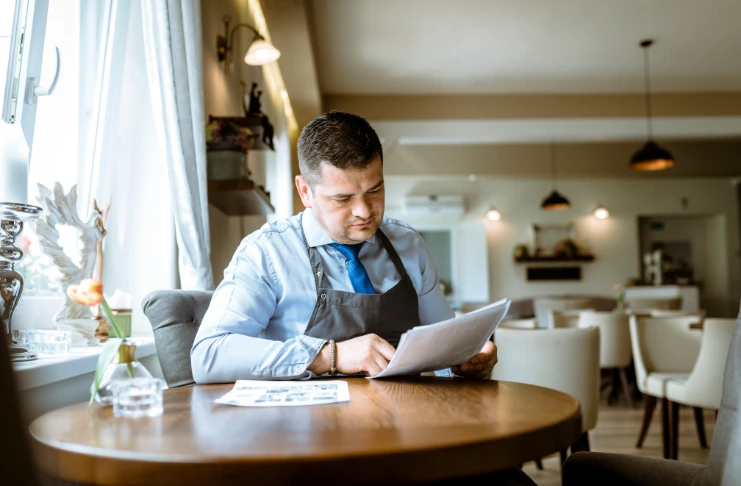Planning to start a restaurant business? You’ll need capital not just to launch it but also to survive the slow months, build a reliable team, manage inventory, market effectively, and stay compliant. The good news is that more restaurant funding options are available now than ever.
But here’s the problem: most restaurant founders either chase the wrong funding source or approach the right one with the wrong pitch. The result? Delays. Denials. And in many cases, a dream that never makes it off the ground.
This guide changes that.
You’re about to go through an ultimate plan on how to get funding for a restaurant, step-by-step, no matter what stage you’re at. So, stick right through.
Section 1: Define Your Restaurant Funding Requirement

Before you speak to a bank, investor, or potential partner, you need to be absolutely clear about how much money you need, why you need it, and where every dollar is going.
Most funding proposals fail not because the idea isn’t good but because the founder hasn’t done the financial groundwork. Remember, investors don’t fund ambiguity; they consider your financial history as part of their decision-making process. They fund well-structured plans backed by data.
So, here’s how to break down your funding requirement with precision:
1. Calculate Your Startup Costs
Start by identifying all one-time expenditures required to launch. These are your startup costs or the expenses incurred before your first customer walks through the door.
Key categories include:
Lease and Deposits: Budget for first and last month’s rent, security deposits, and potential broker fees. In many commercial leases, landlords require 3–6 months of rent upfront.
Renovation and Build-Out: This is typically your largest capital outlay. Costs include structural upgrades, kitchen installation, bathroom compliance, lighting, HVAC, and signage. Depending on your location and design concept, expect to spend $150–$300 per square foot.
Equipment and Furnishings: Think commercial kitchen equipment (ranges, refrigeration, dishwashers), POS systems, front-of-house furniture, sound systems, and decor. Costs range from $75,000 to $400,000 based on scale and service model.
Licenses and Permits: Factor in health permits, liquor licenses, zoning approvals, and music licensing. Liquor licenses alone can range from $12,000 to $400,000, depending on state and county regulations.
Initial Inventory: Stocking food, beverages, cleaning supplies, and disposables before launch typically requires 25–30% of your projected monthly sales.
Professional Services: Legal, accounting, and consulting fees for entity setup, lease negotiation, trademark registration, and financial planning. Allocate $5,000–$15,000.
Insurance: This includes general liability, workers’ compensation, property, and liquor liability coverage. Annual premiums range from $2,000 to $10,000, with a portion due upfront.
Technology Setup: Website, reservation platforms, POS integration, payment processing systems, and inventory software. Budget $5,000–$25,000.
Initial Marketing: Pre-launch campaigns, branding, signage, menu design, and grand opening promotions. Allocate 3–5% of your first-year projected revenue.
2. Project Your Operating Capital Needs
Beyond startup costs, you need enough working capital to sustain operations until you reach break-even.
Your funding should account for:
- Revenue Ramp-Up: Most restaurants take 6 to 12 months to break even. Your budget must cover projected shortfalls during this phase.
- Payroll and Training: Labor costs (including training wages) typically run 25–35% of revenue and begin before the first service.
- Inventory Replenishment: Food and beverage costs will continue at 25–35% of revenue. You need enough runway to maintain supply without disruptions.
- Fixed Costs: Rent, utilities, and insurance persist despite sales fluctuations.
- Marketing Spend: Growth requires sustained promotional activity to drive awareness and customer acquisition.
- Emergency Reserve: Set aside contingency funds for unforeseen disruptions, such as equipment failure, temporary closures, or supplier issues.
A good rule of thumb: secure enough operating capital, potentially through a restaurant loan, to cover at least 12 months of expenses, assuming slower-than-projected revenue growth.
3. Create Your Financial Roadmap

Investors and lenders need to see detailed projections that demonstrate:
- Monthly Cash Flow Analysis: Income and expenses broken down by category for the first 36 months.
- Break-Even Analysis: The exact point where revenue consistently exceeds expenses.
- Three-Scenario Projections: Conservative, moderate, and optimistic revenue forecasts.
- Cost Control Mechanisms: Systems for maintaining food and labor costs at industry benchmarks.
- Return on Investment Timeline: When investors can expect to recoup their capital plus returns.
- Exit Strategy Options: Potential paths to liquidity for equity investors.
Your financial roadmap should not be a fantasy of best-case scenarios. Instead, it should demonstrate a deep understanding of restaurant economics and include contingency plans for common industry challenges.
Section 2: Traditional Restaurant Funding Sources
Now that you’ve defined your funding requirements, it’s time to explore the most established sources of restaurant capital. Each comes with distinct advantages, requirements, and potential drawbacks:
SBA (Small Business Administration) Loans
The SBA doesn’t directly lend money but guarantees portions of loans from participating lenders, reducing their risk and making them more willing to fund restaurants despite the industry’s volatility.
Key SBA Loan Programs for Restaurants:
SBA 7(a) Loans: The most flexible and common option, providing up to $5 million for startup costs, equipment, working capital, or refinancing existing debt. Terms extend up to 10 years for working capital and up to 25 years for real estate.
SBA 504 Loans: These loans are ideal for purchasing property or making major renovations. Up to $5.5 million is available, and terms can be up to 25 years.
SBA Express Loans: These loans are available for smaller capital needs up to $500,000 and have accelerated approval timelines (typically within 36 hours).
SBA Microloans: For smaller funding needs up to $50,000, often with less stringent requirements.
What You Need to Qualify:
- A credit score of 650+ (though some lenders may work with scores as low as 620)
- 10-30% down payment (depends on your restaurant experience and loan type)
- Detailed business plan with 3-5 years of financial projections
- Personal financial statements and tax returns
- Restaurant industry experience or a proven management team
- Collateral (often personal assets like your home)
Typical Terms:
- Interest rates: Prime rate + 2.25% to 4.75% (currently 7.5-10% as of April 2025)
- Loan terms: 7-25 years, depending on the use of funds
- Processing time: 45-120 days from application to funding
Insider Tip: Many restaurant owners mistakenly approach major national banks first. Instead, target community banks or specialized SBA lenders with a track record of restaurant financing. These institutions often have industry-specific expertise and more flexibility in their underwriting criteria.
Conventional Bank Loans
Traditional bank loans typically offer lower interest rates than other financing options, but have more stringent qualifications.
What You Need to Qualify:
- Strong personal credit score (680+ minimum, 720+ preferred)
- Significant collateral (often 100 %+ of loan value)
- 20-30% cash investment from personal funds
- Previous restaurant management experience
- Comprehensive business plan with market analysis
- Detailed financial projections showing a clear path to profitability
Typical Terms:
- Interest rates: 5-9% depending on risk assessment
- Loan terms: 3-10 years for equipment and working capital, 15-20 years for real estate
- Processing time: 30-90 days
Reality Check: Traditional banks approve less than 20% of restaurant startup loan applications. Without a proven track record of operating profitable restaurants, you’ll likely need significant personal assets and a flawless credit history to secure conventional financing.
Restaurant Equipment Financing

If a large portion of your funding need is for equipment, specialized equipment financing can be easier to obtain than general business loans.
How It Works:
- The equipment itself serves as collateral
- Can finance 80-100% of equipment costs
- Terms typically match the expected useful life of the equipment
- This can include installation costs and sometimes even software
What You Need to Qualify:
- Credit score of 600+ (though higher scores secure better rates)
- 1+ years in business (for established restaurants)
- A down payment of 5-20%
- Personal guarantee
Typical Terms:
- Interest rates: 5-15% depending on credit profile and equipment type
- Loan terms: 2-7 years, depending on equipment longevity
- Processing time: As fast as 2-5 business days for established businesses
Unlike general business loans, equipment financing approval decisions focus primarily on the value and longevity of the equipment rather than restaurant success rates. This makes approval more accessible for first-time restaurateurs.
Commercial Real Estate Loans
If you’re purchasing property rather than leasing, commercial real estate loans allow you to build equity while operating your restaurant.
What You Need to Qualify:
- Credit score of 680+ (720+ preferred)
- 20-30% down payment
- Strong debt service coverage ratio (typically 1.25x or higher)
- Detailed property appraisal and environmental assessment
- Personal financial statements
Typical Terms:
- Interest rates: 4.5-7.5% depending on property type and location
- Loan terms: 15-30 years
- Processing time: 45-90 days
While the down payment requirements are substantial, owning your restaurant property protects against rent increases and builds long-term wealth beyond the restaurant’s operating profits.
Section 3: Alternative Funding Sources for Restaurants
Traditional financing often falls short for first-time restaurateurs or innovative concepts that don’t fit conventional lending models. These alternative funding sources can bridge the gap or provide complete solutions:
Friends and Family Investment
Tapping into your personal network remains one of the most common ways to fund a restaurant startup, but it requires careful structuring to preserve relationships.
Two Primary Models:
- Formalized Loans: Clear repayment terms, professionally documented, with interest rates typically 2-5% above the prime rate.
- Equity Investment: Investors receive ownership percentages based on their investment amount, with specific rights and responsibilities outlined in an operating agreement.
Key Considerations:
- Document everything professionally—treat these investments with the same formality as institutional funding.
- Clearly define expectations around repayment or profit distribution
- Create transparent reporting mechanisms on business performance
- Discuss worst-case scenarios upfront to prevent relationship damage
- Consider “hybrid” structures offering both interest payments and small equity stakes
Caution: Never mix funding with operational input unless the friend/family member has relevant industry expertise. Explicitly define decision-making authority in your agreements to prevent “investor syndrome,” where small investors feel entitled to dictate menu items or operational decisions.
Restaurant-Specific Private Investors

A growing network of private investors specializes exclusively in restaurant concepts, bringing capital and industry expertise.
Types of Restaurant Investors:
- Angel Investors: High-net-worth individuals who typically invest $50,000-$500,000 in exchange for equity and often provide mentorship.
- Restaurant Groups: Established operators looking to expand through partnerships rather than direct ownership, offering operational infrastructure alongside capital.
- Hospitality Investment Firms: Professional investment companies focused on food and beverage concepts, typically looking for concepts with multi-unit expansion potential.
What Investors Look For:
- Unique concept with defensible market positioning
- Experienced management team (particularly with prior successful exits)
- Scalability potential beyond a single location
- Systems and processes that can be replicated
- Clear exit strategy within 5-7 years
- Projected ROI of 20-30%+ annually
Where to Find Them:
- Industry networking events and food conferences
- Restaurant incubator programs
- Local restaurant associations
- LinkedIn industry groups
- Restaurant technology vendor networks
Preparation Required: Expect intensive due diligence on your concept, personal background, and financial projections. You’ll need a professional pitch deck, a comprehensive business plan, detailed financial models, and often a proof of concept through pop-ups or small-scale operations.
Crowdfunding Platforms
Restaurant crowdfunding has evolved significantly beyond simple donation models. It now offers sophisticated investment structures specifically designed for food businesses. However, whether you succeed in securing funds through this method depends on these factors:
- Compelling visual storytelling highlighting your concept
- Strong social media presence before launching your campaign
- Clear articulation of what makes your restaurant unique
- Transparent use of the fund breakdown
- Strategic reward tiers that excite potential backers
- Active campaign management with regular updates
Some examples of crowdfunding platforms you can consider are Honeycomb Credit, Crowd4Cash, Crowdo, etc. These platforms facilitate revenue-share investments from community members, with restaurants typically raising $50,000-$250,000 from dozens of small investors while building a loyal customer base.
INDUSTRY INSIGHT
| Lately, crowdfunding has been gaining ground, especially for early-stage restaurants with strong community appeal. Its market is projected to hit US$ 4.45 billion by 2032, showing rising investor interest in alternative financing. Popular models include: – Rewards-Based (Kickstarter): Backers get perks, not equity. – Equity Crowdfunding (StartEngine): Investors receive ownership shares. – Revenue-Share: Investors earn 1.5x–2.5x their contribution via a cut of future sales. – Community Investment Funds: Locals pool resources to back neighborhood restaurants. The right model can bring not just funds but loyal, early advocates. |
Restaurant Incubators and Accelerators
These programs provide combinations of funding, mentorship, shared kitchen space, and industry connections specifically for emerging food concepts.
How They Work:
- Competitive application process evaluating concept viability and founder potential
- Fixed-term programs (typically 3-12 months)
- Seed funding in exchange for equity (typically 5-10%)
- Curriculum covering restaurant fundamentals and growth strategies
- Demo days connecting graduates with potential investors
Notable Restaurant Incubators:
- Kitchen Republic (Amsterdam)
- Food-X (New York)
- The Food Foundry (Chicago)
- Accion Opportunity Fund’s Food & Beverage Program (National)
Beyond funding, these programs provide invaluable mentorship from successful restaurateurs and introduction to potential investors, suppliers, and strategic partners that would otherwise take years to develop.
Vendor Financing

Strategic relationships with key suppliers can also provide significant capital while aligning incentives for mutual success.
Common Forms:
- Equipment Vendors: Many offer in-house financing programs with low or zero interest periods and flexible terms based on your order volume.
- Food Distributors: Major suppliers sometimes provide startup inventory on extended payment terms or offer rebate programs that effectively finance your initial orders.
- POS and Technology Providers: Many now offer “as-a-service” models with minimal upfront costs in exchange for revenue sharing or extended contracts.
- Beverage Companies: In exchange for exclusivity agreements, beer, wine, and spirits distributors may provide fixtures, equipment, and marketing support.
Negotiation Leverage Points:
- Multi-year purchase commitments
- Exclusive supplier arrangements
- Prominent brand placement in your restaurant
- Joint marketing opportunities
- Above-average purchase volumes
Warning: Read the fine print carefully on exclusivity agreements, which may limit your menu flexibility or lock you into unfavorable pricing structures in the long term. Always have these agreements reviewed by an attorney familiar with restaurant contracts.
Section 4: Presenting Your Restaurant to Funders
Even the strongest concept backed by solid numbers can fall flat if not pitched effectively. Your goal is to inspire confidence and show that you understand both the art of hospitality and the science of business.
1. Build a Strategic Pitch Deck
Limit your pitch deck to 12–15 slides. Start with a compelling hook, then lay out the market problem, your unique concept, and proof of customer demand.
Clearly explain your business model, marketing strategy, team strengths, financial projections, and exact funding requirements. Incorporate high-quality images, renders, and infographics to enhance your presentation visually.
2. Prepare to Win the Room

Anticipate investor questions and rehearse your pitch until it’s second nature. Compile a data room with supporting materials like lease proposals and vendor quotes.
If applicable, offer sample tastings or a short pitch video to convey your brand’s essence. Set yourself apart with interactive elements or testimonials from pop-ups to prove traction.
3. Customize by Funding Source
Tailor your approach based on who you’re pitching:
Banks/SBA Lenders: Emphasize financial stability, risk mitigation, and experience. Focus on benchmarks, cash flow, and collateral.
Private Investors: Highlight growth potential for a new restaurant, exit strategy, competitive edge, and profitability metrics.
Crowdfunding: Lead with your story and mission. Showcase visual appeal, community value, and tangible perks for backers.
Family and Friends: Be honest about risks. Set expectations around returns, provide regular updates, and address relationship boundaries upfront.
4. Be Adaptable
Have three versions of your pitch ready: a 30-second elevator pitch, a 5-minute overview, and your whole presentation. Adjust on the fly based on audience interest and feedback.
So, How to Get Funding for a Restaurant?
Securing funding for your restaurant requires strategic preparation, understanding your options, and matching your funding approach to your specific situation. You just need to prove that you’re worth the bet.
Frequently Asked Questions
1. How do I get funding for my restaurant?
You can secure funding through bank loans, SBA loans, private investors, crowdfunding, or personal savings—ideally with a solid business plan and financial projections.
2. Is it hard to get a loan for a restaurant?
Yes, it can be. Restaurants are high-risk, so lenders require strong credit, collateral, and a detailed plan to approve loans.
3. Is $10,000 enough to open a restaurant?
Not typically. Full-service restaurants often need $250,000–$500,000+ to launch. $10,000 may cover a food truck, pop-up, or virtual kitchen.
4. How to get startup funding with no money?
Explore options like crowdfunding, equipment financing, revenue-share models, or pitch to investors willing to trade capital for equity.
5. Can I get an SBA loan to start a restaurant?
Yes, SBA loans like the 7(a) or microloan program are popular for restaurant startups—if you meet eligibility and have some capital or collateral.
6. How much do you have to put down to buy a restaurant?
Typically, 10%–30% of the purchase price, depending on financing terms, lender requirements, and your credit profile.
7. How much does it cost to startup a restaurant?
Startup costs range from $150,000 to $750,000, depending on location, concept, size, and buildout requirements.
8. How do I start my own restaurant with no money?
Start small with a low-overhead model like a ghost kitchen, food cart, or pop-up. Leverage partnerships, pre-sales, or crowdfunding to raise capital.
9. How to get a business loan for a restaurant?
Prepare a strong business plan, detailed financials, and personal credit history, then apply through a bank, credit union, or online lender. SBA loans are a good option.





